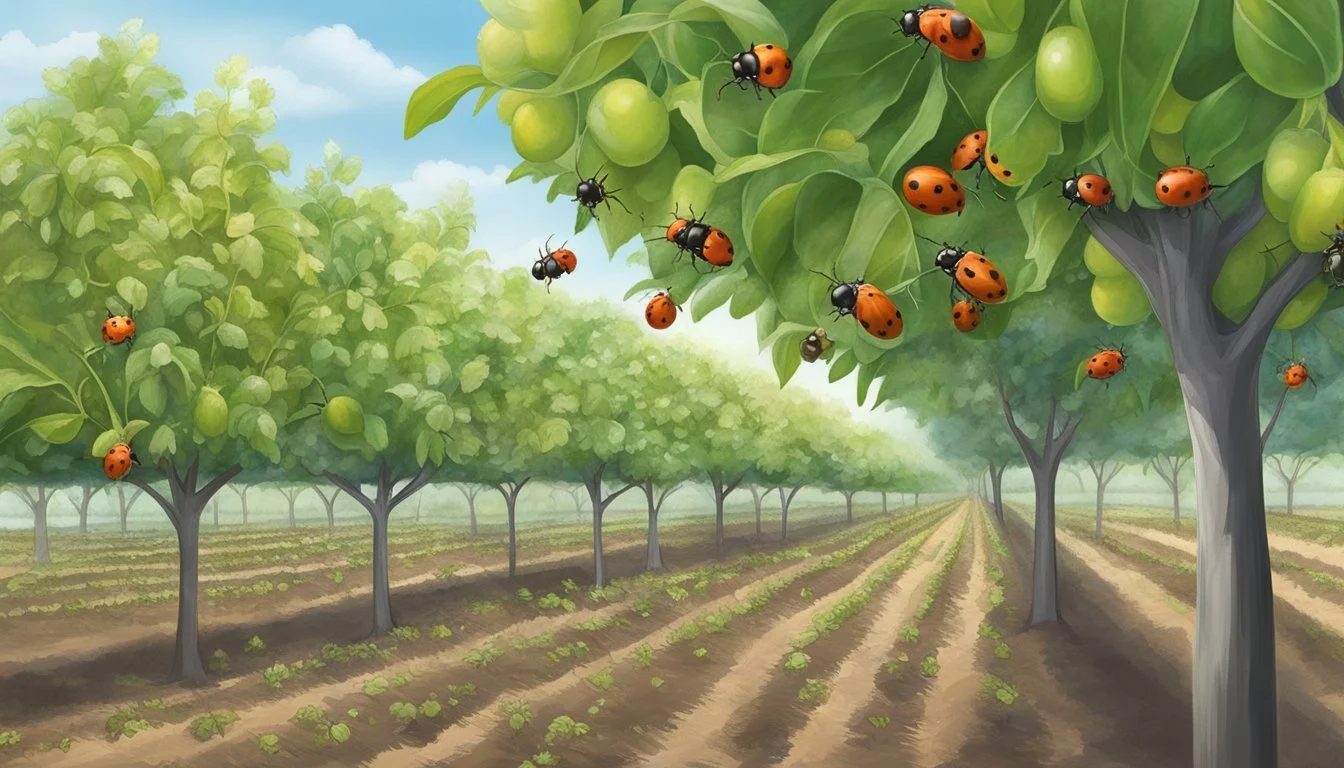Protecting Crops from Mealy Plum Aphids
Effective Management Strategies
Protecting crops from pests is a crucial aspect of agricultural management. The mealy plum aphid, a pest that targets stone fruit trees such as plums, can cause significant damage to crops if not properly managed. These aphids feed on the sap of plants, which can lead to a multitude of problems including leaf curling, stunted growth, and the production of a sticky substance known as honeydew that can encourage the growth of sooty mold on the plants.
There are several strategies that farmers and gardeners can implement to safeguard their crops against mealy plum aphids. These include regular monitoring to detect infestations early, which allows for timely interventions. Natural predators, such as lady beetles and lacewing larvae, play a key role in biological control by feeding on these aphids. In cases of severe infestation, there may be a need for targeted pesticide applications, which should be carefully managed to minimize impact on beneficial insects, especially bees.
Understanding the mealy plum aphid's lifecycle is important for effective control. These aphids have specific summer hosts and overwintering strategies that can be disrupted to reduce their populations. By integrating pest management practices, such as the selective removal of overwintering sites and the encouragement of natural predators, farmers can reduce the need for chemical interventions and promote a healthier, more sustainable agricultural ecosystem.
Understanding Mealy Plum Aphids
The Mealy Plum Aphid, scientifically referred to as Hyalopterus pruni, is a type of pest known for affecting fruit trees, particularly plums. It belongs to a larger family of insects known as aphids.
Characteristics of the mealy plum aphid include:
Color: Pale green or whitish with distinctive markings
Shape: Soft-bodied
These aphids are often discovered on the undersides of leaves, which they tend to curl with their feeding activities. The leaves may exhibit a sticky residue or honeydew, a byproduct of aphid feeding that can lead to further complications such as sooty mold.
Life Cycle:
Wingless adults primarily feed on the sap of plum trees.
Winged forms appear to spread to new host plants.
Mealy plum aphids pose particular challenges to plum crops. They extract nutrients from the plant, which can reduce tree vigor and overall fruit quality. As sap-suckers, they can also transmit plant viruses, intensifying their impact as pests.
Management of these aphids requires an understanding of their biology and careful monitoring of plum orchards to catch infestations early. Integrated pest management practices are often employed to control populations while minimizing harm to beneficial insects and the environment.
Life Cycle and Seasonal Behavior
Understanding the life cycle and seasonal behavior of mealy plum aphids is essential for implementing effective pest management strategies. These aphids exhibit distinct stages and behaviors throughout the year that align with environmental changes and host plant physiology.
Egg Stage and Hatching
Mealy plum aphids lay eggs that overwinter at the bases of plum tree buds. As spring arrives, these eggs hatch during the bloom period. Newly hatched aphids are initially wingless and begin to feed on the opening buds and tender new leaves, marking the start of their life cycle.
Development of Wingless and Winged Adults
The aphids progress through several generations, starting from the wingless nymphs that molt into reproductive wingless adults. As temperatures rise, typically around June and July, some of these adults develop into winged forms. Winged adults are capable of migrating to secondary hosts, spreading infestations across and beyond the orchard.
Overwintering and Reproduction
Towards leaf fall in autumn, mealy plum aphids mate before the female lays eggs that will survive the winter. The adults generally do not survive the cold, but their progeny emerge with the return of favorable conditions in spring. This pattern of overwintering ensures the continuation of the aphid's life cycle each year.
Effects of Mealy Plum Aphids on Crops
The presence of mealy plum aphids in orchards is notorious for causing various negative effects on fruit trees, ultimately compromising both the yield and quality of the produce. The damage extends from direct harm to the trees to a suite of secondary problems.
Fruit Tree Damage
Mealy plum aphids attack fruit trees such as peach, pear, prune, and apricot by sucking the sap from the leaves. This feeding can result in leaf curl, which diminishes the tree's ability to photosynthesize effectively and can lead to a weakened state. The leaf curl plum aphid, a variant of these pests, specifically targets plum trees, causing pronounced symptoms.
Reduced Yield and Quality
The extraction of sap by mealy plum aphids stunts the growth of fruit trees, leading to a reduced yield. The quality of the fruit is also affected; infested trees often produce fruit with lower sugar content, affecting the taste and marketability. The symptoms associated with these pests directly translate into economic losses for growers.
Secondary Problems: Honeydew and Sooty Mold
A byproduct of mealy plum aphid infestation is honeydew, a sticky substance excreted by the aphids. This honeydew can lead to the growth of sooty mold, a fungus that covers the leaves and fruit, hampering photosynthesis further and degrading the appearance of the crop. Additionally, honeydew attracts ants and can encourage the proliferation of plant pathogens.
Monitoring and Identifying Infestations
Effective management of mealy plum aphids requires vigilant monitoring for early signs of infestation and consistent surveillance strategies. Regular checks are crucial to prevent these pests from damaging crops, especially in orchards during favorable weather conditions.
Spotting Early Signs of Aphids
Farmers and growers should be alert for the initial symptoms of a mealy plum aphid attack. These symptoms often manifest as a sticky residue on the leaves or fruit, which is the result of aphid excretions. Another early indicator is the presence of aphids on the undersides of leaves, typically alongside slightly curled-up foliage. Mealy plum aphids are covered with a white mealy wax, making them visibly distinct when scouting for pests. These signs tend to become apparent during bloom, when the aphids emerge from overwintering eggs.
Regular Crop Surveillance
Regular monitoring is essential for maintaining the health of orchards. Surveillance should be carried out at least twice a week when plants are in rapid growth phases, as aphids cause the greatest damage in late spring when temperatures range between 65°-80°F. This can extend into July, when the weather continues to support their lifecycle. In addition to visual inspections, some strategies utilize sex pheromones for mating disruption as a more targeted monitoring method. This approach assists in identifying and managing infestations more effectively. By carefully observing and noting changes in the orchard, growers can take timely action to address these infestations.
Pest Management Strategies
Effective pest management strategies are critical in protecting crops from the mealy plum aphid. Taking an integrated approach that combines ecological, cultural, and biological controls can significantly reduce aphid populations and minimize crop damage.
Ecological Balance with Natural Enemies
Natural enemies play a pivotal role in the ecological balance of agricultural systems. Lady beetles, lacewings, and parasitoids such as parasitic wasps are beneficial predators that actively hunt aphids. By maintaining a habitat conducive to these predators, farmers can enhance biological control and manage aphid populations naturally. For instance, introducing flowering plants can support the lifecycle of these natural enemies, ensuring their presence during critical times when aphids are active.
Cultural Control and Sanitation
Cultural practices, such as pruning and sanitation, are vital for reducing the habitats and food resources available to mealy plum aphids. Removing and destroying fallen leaves and other plant debris from the orchard floor in the dormant season can decrease the number of overwintering aphids. This proactive step is crucial to limiting the initial aphid population at the start of the growing season.
Biological Control Methods
The introduction and conservation of biological control agents, such as beneficial insects, is a cornerstone of an integrated pest management strategy. Deploying beneficial insects like lady beetles and parasitic wasps that specifically target mealy plum aphids can result in effective long-term control. These natural enemies work by either consuming large numbers of aphids or disrupting their life cycle. Moreover, when applied appropriately, biological control methods can be a safe and environmentally friendly alternative to chemical pesticides.
Chemical and Organic Treatment Options
When it comes to combating mealy plum aphids, it is crucial to consider both chemical and organic treatment strategies to effectively control the population while being mindful of environmental impacts and the potential for resistance development.
Using Insecticides Responsibly
Responsible use of insecticides is essential to control mealy plum aphids effectively without contributing to resistance or causing undue harm to the environment. Farmers should always read and adhere to the label directions when applying chemicals such as esfenvalerate or chlorpyrifos. Using the correct dosages not only ensures the effectiveness of the treatment but also mitigates potential risks to non-target organisms. Regular monitoring and employing insecticides as part of an integrated pest management (IPM) approach can reduce the use of harsher chemicals and the likelihood of aphids developing resistance.
Organic Controls and Mineral Oils
For those seeking organic methods for aphid control in home gardens or on a larger scale, options include neem oil, insecticidal soap, and horticultural oil. These organic controls act in various ways—from disrupting the insect's life cycle to suffocating the pests on contact. Mineral oils, another viable organic treatment, can control aphids by obstructing their breathing pores. Always apply during appropriate weather conditions to maximize effectiveness and minimize plant stress. These organic treatments require thorough application to infested areas and may necessitate multiple applications for complete control.
Preventive Actions and IPM
Preventive measures and Integrated Pest Management (IPM) are essential strategies in the fight against mealy plum aphids. These approaches emphasize long-term prevention and control, focusing on cultivation and monitoring techniques that minimize the reliance on chemical pest control methods.
Cultivating Resistant Varieties
Research indicates that cultivating crop varieties with inherent resistance to aphids can greatly reduce the likelihood of infestation. Selecting and planting these resistant varieties, particularly with crops such as pear and nut trees, is a foundational step in any IPM program. The genetic makeup of these plants makes them less attractive or more tolerant to pests, thus providing a solid line of defense against mealy plum aphids.
Implementing Integrated Pest Management
Integrated Pest Management (IPM) strategies incorporate a variety of control methods based on regular monitoring of aphid populations and weather conditions. These strategies may include:
Biological Control: Employ natural predators such as ladybugs to manage aphid levels.
Cultural Practices: Alter planting times or patterns to outsmart aphid life cycles.
Physical Controls: Use water sprays to dislodge aphids or apply barriers to prevent their access to plants.
Chemical Controls: Apply pesticides as a last resort, and choose options that are least harmful to beneficial insects and the environment.
The effectiveness of IPM lies in its adaptability; it allows growers to respond to aphid activity in real-time with the most appropriate and least invasive control method available.
Understanding the Role of Environment and Weather
The life cycle of mealy plum aphids is intricately connected to environmental conditions and weather patterns. These aphids tend to thrive in certain weather conditions, and understanding these can assist farmers in managing their populations.
Temperature: Mealy plum aphids are most prevalent in mild temperatures, typically between 65°-80°F. Above or below this range, their activity and reproduction rates may decline.
Overwintering: The aphids overwinter in the egg stage, attached to the base of buds on host plants. They emerge during bloom in favorable weather, which usually coincides with the start of spring.
Moisture and Humidity:
Aphids favor areas with moderate humidity, which aids in their survival and reproduction.
Excessive rain can negatively impact aphid populations as it can physically displace them or make the environment less suitable for their growth.
Migration and Wind:
Winged aphids may migrate to new host plants, and their movement can be influenced by wind patterns. On windy days, they can travel significant distances, spreading infestations.
Environmentally, the mealy plum aphid finds protection in the slightly curled-up leaves of its host plants, creating a microhabitat less affected by harsh weather elements. These natural shelters provide a stable environment to feed and reproduce.
Cattails do not have a direct relationship with mealy plum aphids as the pests prefer fruiting trees, specifically stone fruit trees, rather than wetland plants.
By recognizing these environmental factors, farmers can better predict and manage aphid populations, protecting their crops with environmentally tuned strategies. Monitoring local weather and adjusting pest control measures accordingly plays a pivotal role in effective aphid management.
Resources for Growers
Growers aiming to fend off mealy plum aphids have a wealth of resources at their disposal. Below are some notable avenues for information and assistance.
Educational Materials:
Numerous extension services provide literature on pest management:
The University of California Statewide Integrated Pest Management Program offers comprehensive guidelines on managing aphids in a variety of crops.
Utah State University Extension provides resources specifically about aphids affecting fruit trees.
Online Resources:
Websites offer targeted advice for combating aphids:
UCANR's Mealy Plum Aphid page details life cycle and control strategies.
The PlantwisePlus Blog provides an overview of mealy plum aphid impact and response techniques.
European Services:
European growers can consult resources such as the European and Mediterranean Plant Protection Organization for region-specific guidance.
Assistance Programs:
In California, local Cooperative Extension offices extend direct support to growers.
Government & Organization Links:
USA, UC IPM, ucanr.edu/PMG/PESTNOTES/pn7404.html
USA, USU Extension, extension.usu.edu
Europe, EPPO, eppo.int
These resources provide education and practical tips on identifying, monitoring, and controlling mealy plum aphid populations effectively. They offer regional insights and proactive measures to maintain crop health and mitigate pest damage.
Frequently Asked Questions
This section addresses common inquiries regarding the prevention, identification, and treatment of mealy plum aphids in cultivation.
What are the effective natural remedies to deter mealy plum aphids?
Natural remedies to deter mealy plum aphids include introducing beneficial insects like ladybugs and lacewings, as these predators feed on aphids. Another method is applying soapy water to infested plants, which can help remove them without harming the crops.
How can neem oil be used in the treatment of plum aphids?
Neem oil, a natural pesticide, is effective against plum aphids when mixed with water and sprayed onto affected plants. It disrupts the life cycle of the aphids and deters them from feeding without causing damage to the plant itself.
What home remedies can protect crops from aphid infestation?
Home remedies for protecting crops from aphid infestation include spraying a mixture of water and a few drops of dish soap or applying a garlic or chili pepper spray, which acts as a repellent due to their strong scents.
What are the signs of aphid damage on plum trees?
The signs of aphid damage on plum trees include curled leaves, stunted growth, and a sticky substance called honeydew, which can lead to the growth of black sooty mold.
What methods do farmers implement to prevent aphid outbreaks?
Farmers prevent aphid outbreaks by monitoring their crops regularly for early signs of infestation, implementing biological control agents, maintaining crop health to improve resistance, and using row covers to physically block the pests.
Which pesticides are considered safe and effective for aphid control on vegetable crops?
Pesticides that are safe and considered effective for aphid control include insecticidal soaps, horticultural oils, and certain chemical insecticides labeled for use on edible crops. Always check the label for application rates and safety intervals between treatment and harvest.







